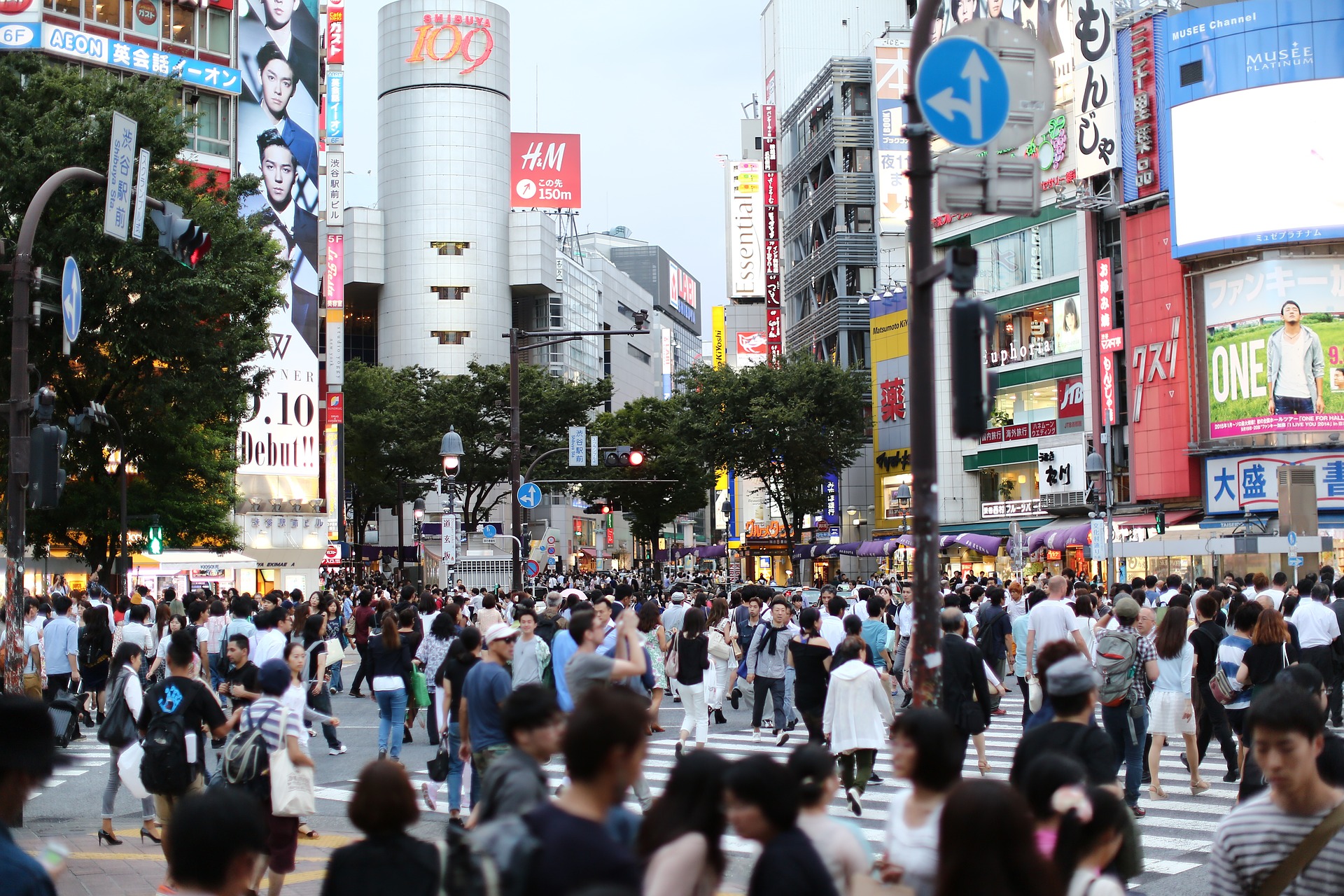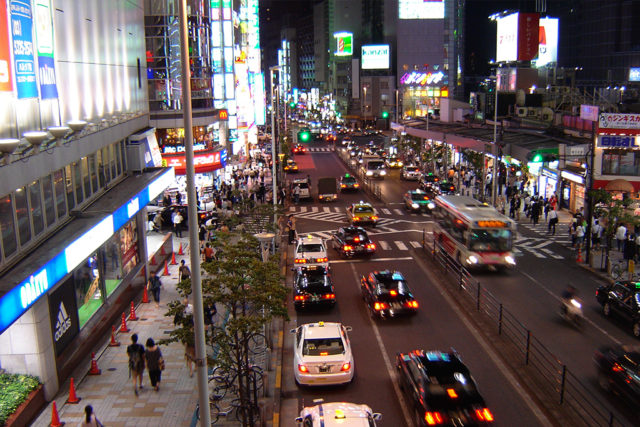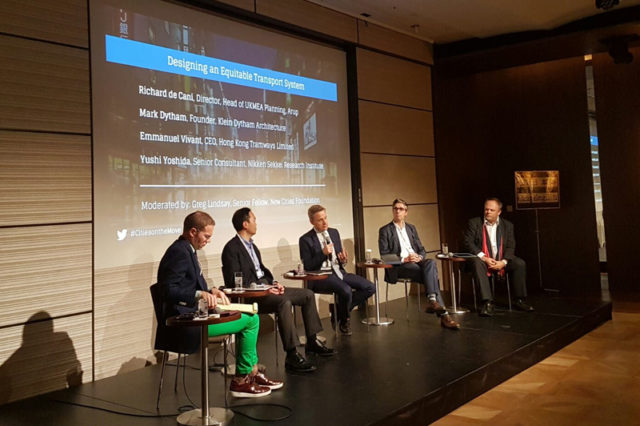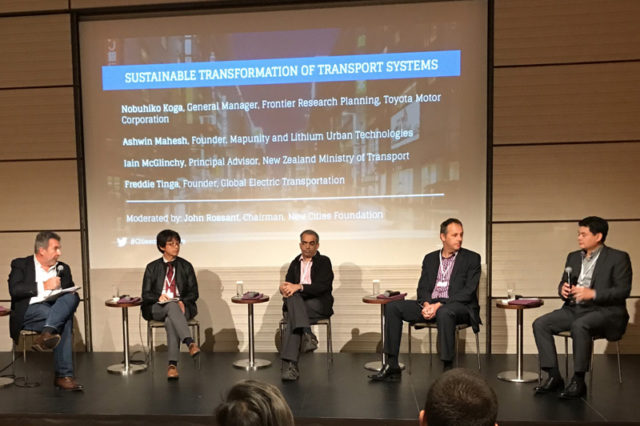
Cities on the Move: Public and Private Must Drive Together
November 16, 2016 — Blog
Tokyo, Japan – On Friday, 4 November, 2016 NewCities welcomed 150 of the leading practitioners and forward thinking experts to discuss the changing nature of urban mobility at Cities on the Move. The event was supported by Toyota Mobility Foundation, X, and was hosted by Mori Building.

A revolution in urban mobility is happening in cities around the world. In the clogged streets of Manila, Lagos, Tokyo and Los Angeles, new actors and technologies are increasingly making their mark on the city. More often than not, this revolution is emerging in the voids created by limited public transit offerings, slashed budgets, and a failure to reimagine mobility systems to match the pace of growing congestion.
In cities characterized by poor access and distended transportation networks, disruptive changes to the mobility landscape are often welcome, but what will this look like? What opportunities might this revolution bring, and at what cost?
Cities on the Move faced these questions head on, focusing on the technologies, tools and actors that will play a part in defining this revolution and steering it towards more effective and equitable outcomes.
With 150 experts from a myriad of fields and more than 25 countries, the one-day event supported the common understanding that urban transport serves a much greater purpose than to simply move people from one point to another; it dictates economic well-being, access to services and quality of life as a whole. As Director of Programs and Partnerships at Toyota Mobility Foundation, Ryan Klem, said on-stage: “Our society is where we are today because of mobility”.
Advancements in mobility are moving very quickly. At the intersection of several discussions, three main themes emerged as the most significant considerations behind smarter connected mobility, namely, the need for public sector to play a larger role, the opportunities presented by big data, and the promise of new transportation technologies.
Integrated Transport: an Evolving Public Sector Role in Urban Mobility
One of the thematic threads that ran throughout the conversation was reformulating the role of the public sector in providing adequate mobility options for its growing citizen base. Understanding the gaps in existing public transportation networks and the various ways that technological innovations may bridge these voids was an important first step.
The city must act as an investor and activist for helping keep these [mobility] tools in place, affordable, and manageable.
Seleta Reynolds, General Manager of LADOT
We are in a position where the public sector risks being eclipsed by this rapid technological change. In many cities, the fear is a future where those that rely most on public transit — those often unable to afford private transportation — see their service increasingly crippled, effectively removing them from the urban mobility equation. Participants at Cities On the Move 2016 agreed the key is to make our cities’ transit radically more flexible.
A common criticism you hear is that public transport takes us from where we’re not to where we don’t want to be. The last mile is key.
Eric Hannon, McKinsey & Company
Adopting the role of mobility orchestrator can allow cities to leverage emerging innovations in on-demand mobility to create the flexible transportation systems residents want, and that the spatial layouts of many cities need. This position can also ensure that the city claims leadership in driving change and writing the rules of engagement, aiming to better share the benefits of a mobility revolution. In this regard, our Connected Mobility Roadmap, as well as innovators in the Philippines, make the case for micro-transit for their potential as centrally managed fleets that could flexibly extend mobility service and coordinated public transit access to the residents that need it most.

Deciphering the Data
Smarter, more flexible mobility systems are really about making better use of the capacity cities already possess in their street, transit, and cycling networks. The panel on data’s contribution to the future of mobility proposed that a crucial goal for cities should be standardizing and enabling the sharing of data between urban mobility actors. But how can so many streams of data be put to use for achieving what Masaki Ogata, President of UITP, calls ‘shorter total trip time’ (or STTT) and better access to mobility for everyone? After all, this is a significant factor for all residents seeking to get around the city and can convince more people to rethink private car ownership and single-occupancy commuting.
While the prospects of ‘smart city’ sensors and new streams of valuable data are enticing, there is a great need for the public sector to understand how to assess the data they already have. Feng Yuan Liu of the Technology Agency of Singapore remarked that Singapore has realized that for enhanced urban mobility, the city had to hire data scientists to ensure comparable and compatible data sets are created, shared, and analyzed to work on policy effectively.
We blindly accept terms of service when downloading private apps on our phone, but we have an issue when the public sector wants to collect it. We don’t understand what that could mean for the public good.
Ashley Hand, Co-founder, Cityfi
In order to move more people through the city more quickly, policy and standards for sharing the congestion data and existing public transit information feeds can play a key role in planning. Ultimately, if managed and shared effectively, data is a powerful tool to inform better demand management, last-mile solutions, emerging private sector niches, and overall network optimization.

Approaching a Sustainable Future?
The discussion at Cities on the Move 2016 raised many important questions about the path that the public sector and mobility industry are on and the importance of planning for the years ahead. Importantly, the physical technologies and digital systems that will shape this future mobility are constantly evolving, while the goal of a sustainable, affordable and equitable network for people to get around the city is relatively fixed.
Hydrogen and new cleaner technologies are no silver bullet for traffic jams, but they will limit air pollution.
Nobuhiko Koga, General Manager, Frontier Research Planning Department, Toyota Motor Corporation
How will these changes phase into everyday life in cities, and what considerations need to be kept in mind for coordinating the mobility revolution that has already begun? “We need a more scientific, balanced approach” to chart the path forward, said Toyota Motor Corporation’s Nobuhiko Koga. “Energy, for example, is just one part of the problem for sustainability and urban mobility. Hydrogen and new cleaner technologies are no silver bullet for traffic jams, but they will limit air pollution”. Understanding the role and implications of each technology, and supporting their development within a city’s vision for its mobility future will be key.
Autonomous vehicles and other advanced technologies hold enormous potential for increasing the efficiency of transportation networks. However, uncoordinated fleets of independent operators and a hollowed out mass transit system are a probable outcome if these technologies and the public sector are not working together.
In the brighter scenario, forward thinking companies and transit agencies will create seamless networks that enhance the benefits of mass transit and the reality on-the-ground. In this world, a commuter shares an on-demand connection to mass transit, a private autonomous shuttle for a meeting at lunch, and takes a bike home – compelled by the advantages of one connected system and worry-free trip planning. This can only be the product of sectors and complementary systems working in harmony.